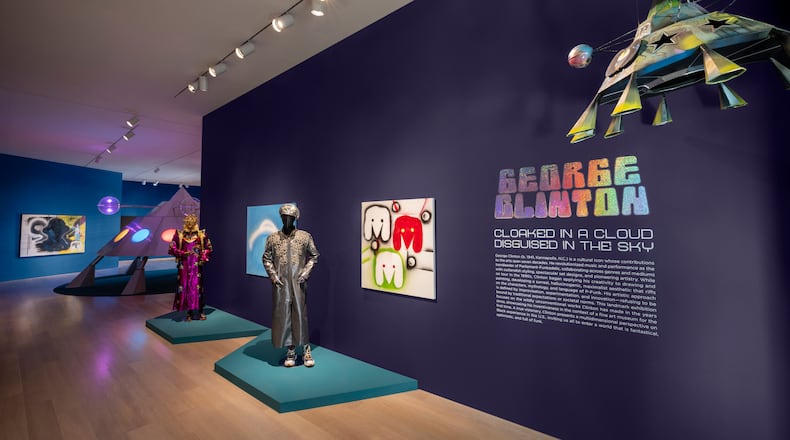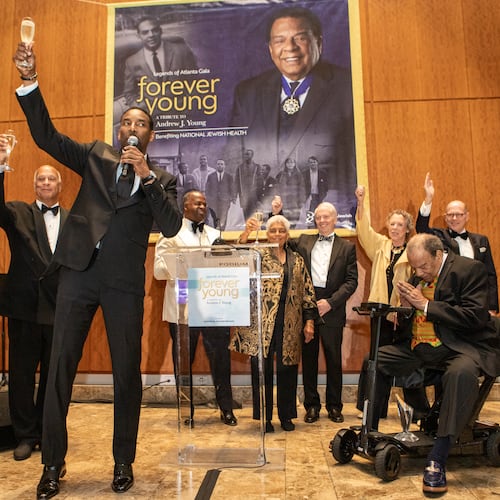Walking into “Cloaked in a Cloud, Disguised in the Sky,” the first public exhibition of art created by George Clinton, feels similar to stepping into Parliament-Funkadelic’s mothership.
One only has to imagine being inside a spacecraft adorned with interstellar Black art, drawings created on hotel stationary, photography and otherworldly costumes worn by the iconic funk music singer, producer and pioneer over the years.
There’s also an interactive control room in another area of “Cloaked,” where visitors can watch music videos of songs Clinton created in collaboration with artists like Ice Cube, who along with other West Coast gangster rap artists were inspired heavily by Parliament-Funkadelic music.
Credit: Nick Berryman
Credit: Nick Berryman
The exhibit includes several interpretations of the “Atomic Dog,” represented most often as a spray-painted doodle resembling a long-eared, beady eyed canine. Clinton created the image as an alternative to a traditional autograph for his fans, he told an audience of students, faculty and fans on Sept. 26, addressing the crowd as SCAD Museum of Art’s 2024 Jacob and Gwendolyn Knight Lawrence Lecture speaker.
When Clinton stepped onstage after being introduced, wearing sparkling gold and silver loungewear and thick pink sneakers, it wasn’t to perform. Dr. Funkenstein was in Savannah to talk art, in a live interview with Daniel Palmer, SCAD Museum’s chief curator.
Students, faculty and fans gave cheerful applause as Clinton strolled to his seat and answered questions about his inspiration, process and creative methodology. It all began with the dog doodle, he told onlookers.
“That became my signature. And over the years I started finding people would come back 10 years later with the dog I’d done, and they want another dog. So I’d do it again and again.”
Credit: Nick Berryman
Credit: Nick Berryman
Clinton told Palmer his interest in creating art was also motivated by Parliament-Funkadelic’s album artwork, created by artists like Overton Loyd, who attended the lecture. “I can read the albums 10 years later and find stuff on there that I had never seen,” he said.
He also spent time drawing in hotel rooms while traveling for performances and lacking other means of recreation. He added that he probably would have never shown anyone his creations if not for this exhibit.
Credit: Nick Berryman
Credit: Nick Berryman
“All those little doodles I did, in the dark sometimes, [I] did when you didn’t have nothing else to do. It all becomes part of the lineage of the art.”
Clinton has been colorblind his whole life — an interesting factor not only when considering his art but his personal sense of style. His use of shiny metallic hues in paintings are familiar to P-Funk fane who’ve seen him modeling outrageous, often-intergalactic-themed attire, not to mention the colorful assortment of hairstyles he’s worn throughout his career.
Credit: Nick Berryman
Credit: Nick Berryman
He didn’t realize he had a decreased ability to discern color differences until his mother first brought home a color television when he was a child. His condition became clear when he couldn’t tell the difference from their previous black-and-white set. Yet Clinton credits his experience as a former barbershop owner, and the designs and hairstyles he learned to create for 10 years in his twenties, prior to forming P-Funk, with influencing his artistic sensibilities and approach.
“I know how to make shapes and things without color being involved,” he said. “Today’s haircuts and all the designs people have, we were doing that back then. You might not call it art, but that’s what it was.”
Afrofuturism is explored throughout “Cloaked in a Cloud, Disguised in the Sky,” and Clinton provided personal perspective on the origins and significance of the concept in his artistic practice. He said his interest in the idea and its philosophies evolved from the influence of artists like Jimi Hendrix.
“We were calling it Afrofuturism back then, even in 1968 and ‘69,” he said onstage, relating the modern resurgence of science-fiction-inspired ideas of Black people existing beyond Earth to his own musical curiosities and psychedelic philosophies.
“I’ve done that before, so I don’t have to go too far back to be relevant again,” he said.
The exhibition includes replicas of P-Funk’s UFO-like space vehicle, whose original version was used for decades as a stage prop while the band performed on tour (Clinton donated the original mothership to the Smithsonian in Washington, D.C., in 2011).
A smaller version made from metal, canvas and foam, hangs from the ceiling near the entrance. Another giant rendition, built by Palmer’s team at the museum, is equipped with colorful, foggy windows and a stereo system programmed with songs from Clinton’s musical catalog.
Credit: Nick Berryman
Credit: Nick Berryman
It’s a strange, vivid and fun trip through the mind of one of history’s most influential creatives, where graffiti, fashion, sound and color combine for something that’s neither too high to get over nor too low to get under. Together, the pieces provide space-aged visual context for some of Clinton’s most liberating lyrics and out-there perspectives, which were mostly represented to the public through sound until now.
Attorney Benjamin Crump also attended the lecture and spoke with The Atlanta Journal-Constitution about Clinton’s cultural maven status after seeing the exhibition. “I think George uses his influence in a very unique way with his music. He brings people together, and he shows them the talent of all people,” Crump said.
“Look how good the sound is when we’re all playing together. I think that’s what’s so great about George. And now he’s doing it with art.”
Clinton performed in Atlanta with Parliament-Funkadelic in 2019, in what was billed as his final show with the group.
While Clinton seemed to thoroughly enjoy discussing his art with students and fans, he admitted not being overly concerned about how it will be received by museum visitors.
“In the music I’ve created, as well as in my approach to art, I’ve always tried to push boundaries and not be confined by conventions or expectations. The idea of ‘freeing your mind’ is about tapping into your imagination, being open to the absurd and unconventional, and not worrying about what others might think. It’s about allowing your creativity to flow freely, drawing inspiration from the world around you and your own unique perspective.”
Credit: Robb Cohen Photography & Video/
Credit: Robb Cohen Photography & Video/
He added that coming into his own creatively in the 1960s pushed him to venture as far as possible from the status quo, even today.
“It allowed me to see things from a different angle, to make connections that others might miss, and to create art and music that resonated on a deeper level,” he said.
“I never thought I knew what I was doing anyway,” Clinton admitted with a laugh.
“Cloaked in a Cloud, Disguised in the Sky”: Sept. 26 - Jan. 27. SCAD Museum of Art, 601 Turner Boulevard, Savannah. SCAD.edu
Become a member of UATL and sign up for the UATL newsletter.
Read more stories like this by liking UATL on Facebook and following @itsUATL on X and Instagram.
About the Author
Keep Reading
The Latest
Featured












